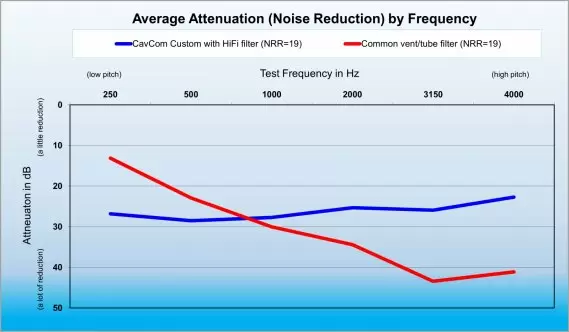How do CavCom‘s high-fidelity filters work and how are they different from traditional filters and vents?
Rather than blocking airborne particles of different sizes like a respirator, an acoustic filter passes or blocks different frequencies of sound. Closing off the earcanal, such as when wearing a typical earplug, suppresses the earcanal's natural amplification of high frequency sounds. In addition, subtle leaks around a hearing protector let through more low frequency sounds (with larger wave lengths) than high frequency sounds (which have very short wave-lengths). Since the attenuation (reduction) of sound is less at low frequencies than high frequencies, the result of wearing a typical earplug or earmuff is that incoming sound is distorted or unbalanced – the "bass" louder than the "treble." When it comes to speech, high frequency consonants are attenuated more than lower frequency vowels, resulting in a perception of mumbled or muffled speech.
To achieve a more even, or "uniform," attenuation of sounds across all frequencies, it is necessary to control sound leakage around the hearing protector to ensure the correct attenuation at low frequencies. At the same time, attenuation at high frequencies must be limited in order to achieve a more balanced sound quality. Specialty high fidelity filters are made by using a membrane which seals the ear but at the same time vibrates well at high frequencies to achieve a consistent amount of sound reduction across low and high frequencies.
CavCom‘s high-fidelity acoustic filters use a patented membrane technology to achieve the desired uniform attenuation result. Compared to open vents or small resistive tube technology, our filters have a relatively large aperture that allows more natural sound transfer across the mesh layers inside the filter. Since the membrane is made of a breathable material, there is also less occlusion effect or "plugged up" sensation. Discomfort and over-protection are two of the main factors that result in failure to use hearing protection properly. Our advanced technology is tuned specifically for comfort and to maintain natural hearing of speech and other important sounds in the workplace.
Example: Compare the performance of CavCom‘s Hi-Fi filter to a traditional vent/tube filter in the graph below. Both hearing protectors have an overall NRR of 19, but the tube filter (plotted in red) provides an uneven amount of protection – very little reduction at low frequencies (pitches) and a great deal of reduction at high frequencies. This results in significant distortions, perceived as mumbled speech or a "boomy" quality to sounds. In contrast, the CavCom filtered hearing protector (plotted in blue) provides a fairly even/uniform amount of reduction throughout the frequency range. This preserves the integrity of the original speech signal or other environmental sounds outside the ear. Listeners report "crispness" of sounds and improved speech intelligibility.

To learn more about avoiding OVERPROTECTION, read our SoundBytes article.
Contact CavCom to learn more about high fidelity filters to help improve communication, safety and efficiency in your moderate noise environments and hearing-critical jobs.
- How often should custom earplugs or earsets be replaced?
- What is NRR or Noise Reduction Rating?
- What is the Personal Attenuation Rating (PAR)?
- Why do OSHA formulas require us to subtract 7 dB from the Noise Reduction Rating (NRR)?
- Does OSHA require hearing protection de-rating (cut the Noise Reduction Rating (NRR) in half)?





